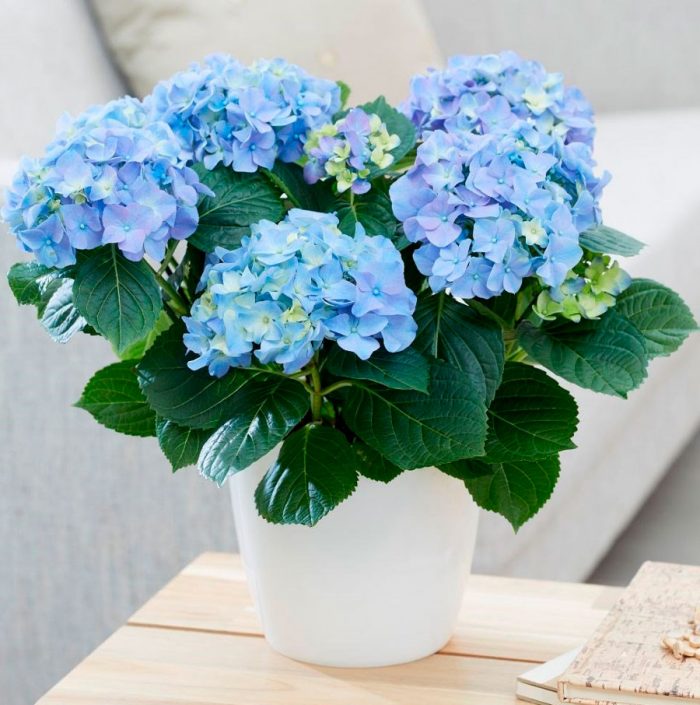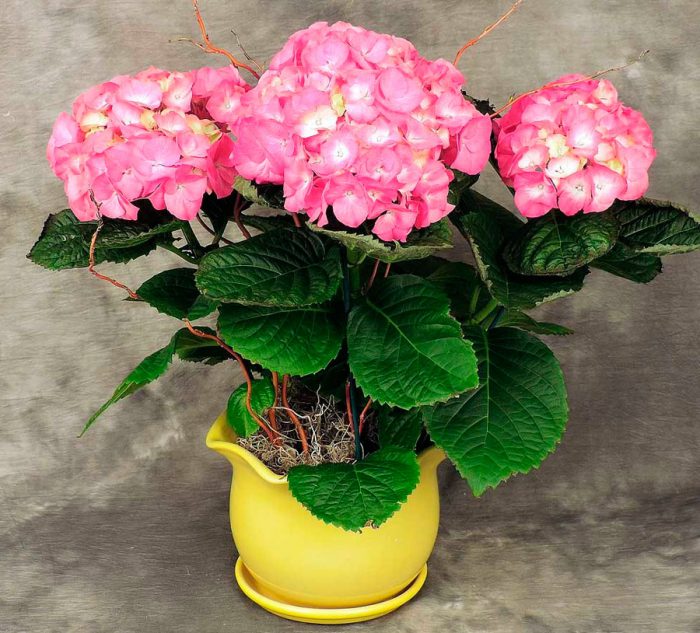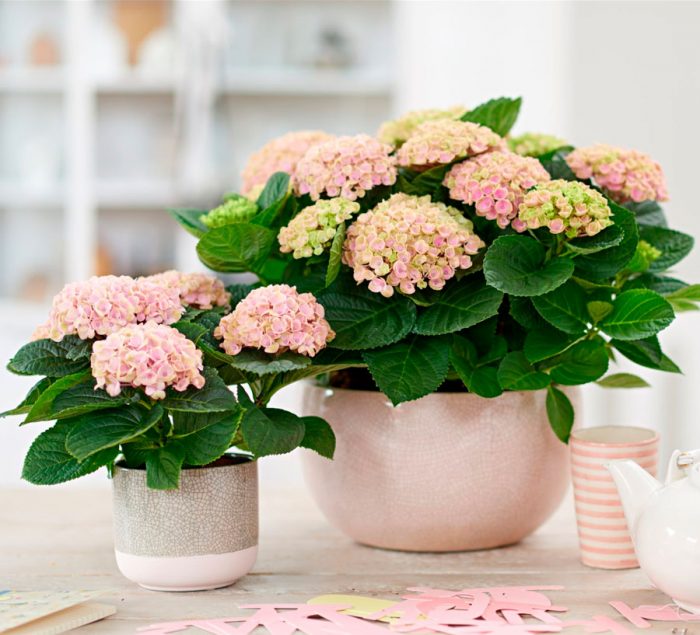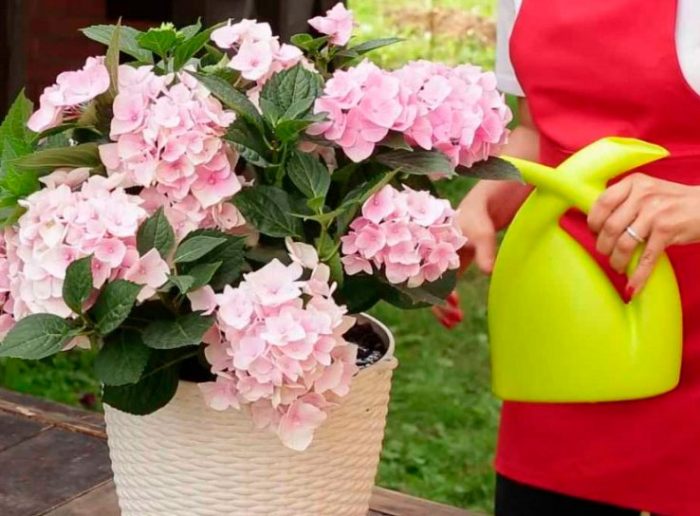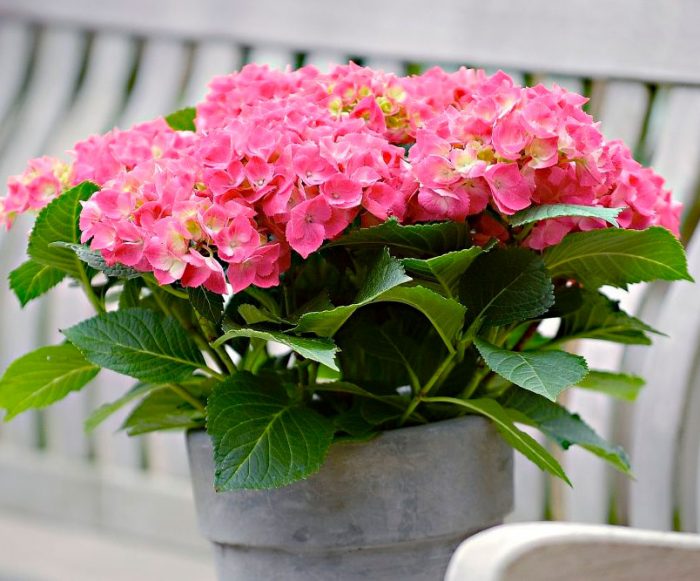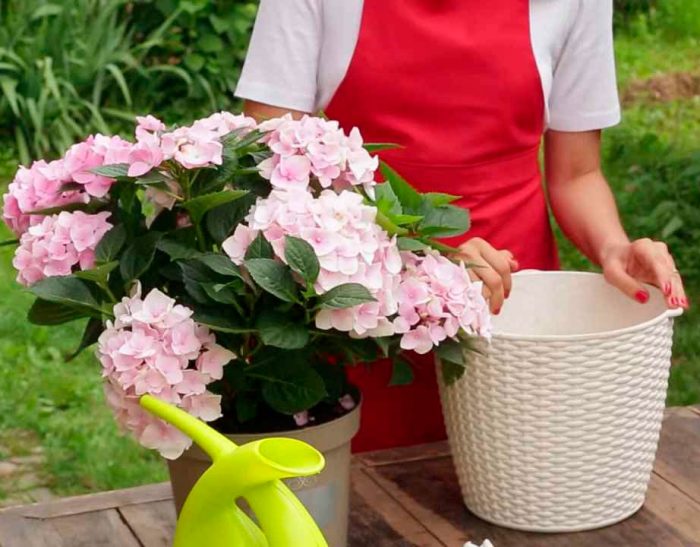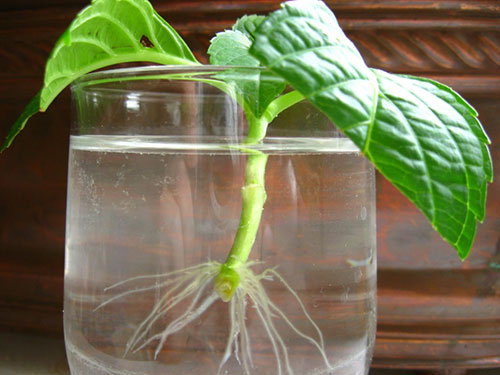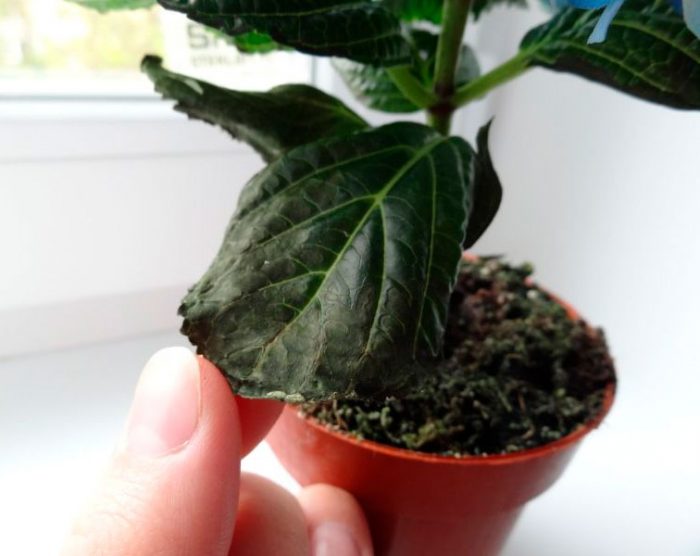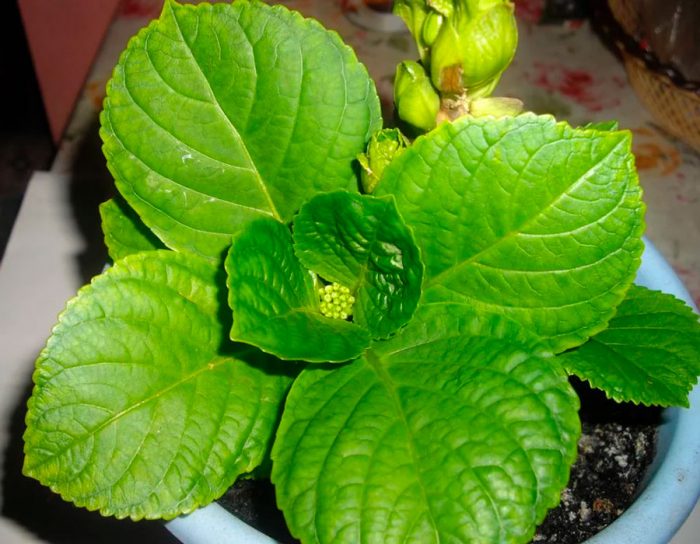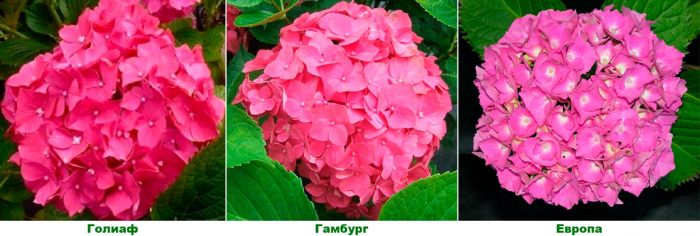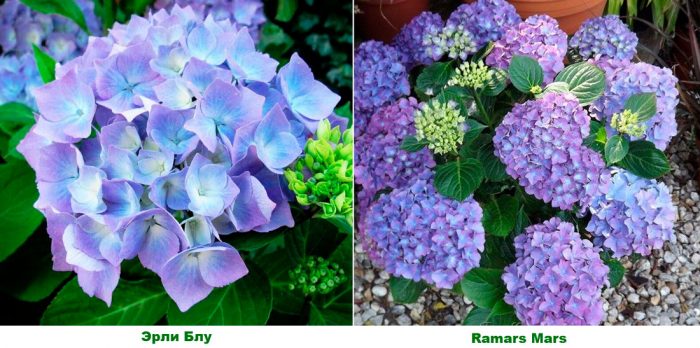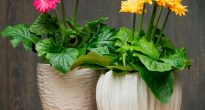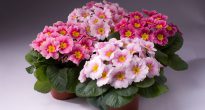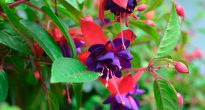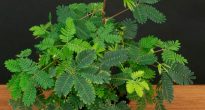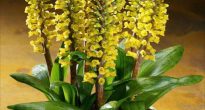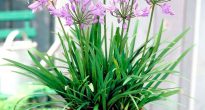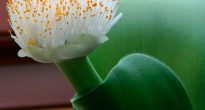Hydrangea (Hydrangea) is a member of the genus of flowering plants of the Hydrangea family. This genus unites about 80 species, while it is represented by shrubs and small trees. Under natural conditions, this plant is found in South and North America, Japan, China and other countries of South and East Asia. This plant was named after one of the princesses of the Holy Roman Empire. And botanists-taxonomists called it "hydrangea", which is translated from ancient Greek as "a vessel with water." This is due to the fact that the plant is very moisture-loving.
In the indoor culture of European countries, hydrangea appeared in 1820. Later, it began to be cultivated in the open field. As soon as flower growers and gardeners began to grow hydrangeas, experts began to breed. Thanks to them, many varieties and varieties were born. Today this flowering plant can be found not only in the garden, but also in a pot on a terrace, veranda or balcony.
Content
Brief description of cultivation
- Bloom... It starts in April and ends in November.
- Illumination... The light should be bright, but diffused. To do this, it is enough to place a bush not far from the south-facing window (at a distance of 200–300 cm).
- Temperature regime... During the growing season - about 20 degrees, and during the dormant period - from 7 to 10 degrees.
- Watering... In the summer months, the bushes need abundant, frequent watering. In the spring and autumn, watered more rarely and in moderation. During the dormant period, they rarely and scarcely moisten the soil.
- Humidity... Requires high humidity. On hot days, the bush should be moistened as often as possible from a spray bottle.
- Fertilizer... Top dressing is carried out in the period - February – October. To do this, use a mineral complex for flowering plants (heathers, azaleas and rhododendrons), and fertilize the soil twice a month. In winter, the plant does not need fertilization.
- Dormant period... Observed in December and January.
- Transfer... It is carried out only for indoor hydrangea every year, while its life expectancy is 3 to 4 years.
- Pruning... In the autumn, when the bushes have faded, it is necessary to cut off the weakened stems, and also to shorten the powerful shoots by ½ part of the length. When spring comes, cut out any weak stems that have stretched strongly during the dormant period.
- Reproduction... Cutting, dividing the bush and seed method.
- Pests... Spider mites and aphids.
- Diseases... Peronosporosis and gray rot.
Features of home hydrangea
Home hydrangea is a perennial dwarf shrub. Its large, opposite leaf plates have an ovoid shape and a serrated edge. Their length is 10-15 centimeters. Quite large spherical inflorescences in diameter can reach about 35 centimeters. They have the shape of a shield, umbrella or brush, while they include flowers of two types: in the center there are small fertile ones, and at the edges - larger sterile ones. The uniqueness of this plant is that the color of its inflorescences is directly dependent on the hydrogen index of the land on which the bush grows:
- acidic soil - bluish color;
- neutral - cream or white;
- alkaline - pink or lilac.
At the same time, all the petals of flowers are colorless, but their sepals have a rich color, which makes the inflorescences decorative. The fruit is a polyspermous capsule. When grown indoors, the height of the bush can be up to 100 cm.
Hydrangea care at home
Hydrangea grown in room culture is able to please the grower with abundant and long flowering, but only if optimal conditions for growth are created for it.
Lighting
Hydrangeas need a lot of free space, but they also need quite a lot of light. However, the bush should not be exposed to direct sunlight. For example, it can be placed 2-3 meters away from a south-facing window.
Temperature regime
The plant feels best at a temperature of about 20 degrees. At the same time, it must be protected from sudden changes in temperature and from drafts. When the shrub has faded, it will begin a dormant period. At this time, he is placed in a dark place where the air temperature is kept at 7-10 degrees. The bush should be there until the buds begin to awaken in February. After that, it is returned to its usual place. This wintering allows hydrangeas to quickly regain their strength. If the bush hibernates under normal conditions, then it will bloom again only after 1 year.
Watering
When growing hydrangeas, special attention should be paid to watering it. It should be systematic and abundant, since this plant is very moisture-loving. In the summer, the soil mixture in the pot is moistened abundantly and quite often, and in the spring and autumn, moderately. With a cool dark wintering, the bush is watered only in order to prevent the earthen coma from completely drying out.
Water suitable for wetting the substrate should be filtered, well-settled or thawed. You can also use rainwater, but only if you live in an ecologically clean place. Do not forget to water the bush with water mixed with lemon juice 1 time in 30 days (5 drops of juice per 1 liter of water).
Air humidity
The plant needs high humidity. Therefore, a place is chosen for it, located away from working heating appliances, and it must also be systematically moistened from a spray bottle.
Top dressing
During the growing season, the hydrangea must be fed with a frequency of 1 time in 15 days.For this, mineral complexes are used for flowering plants (rhododendrons, heather and azaleas). The first feeding is carried out in February, after young shoots appear on the bush. In winter, it is impossible to fertilize the substrate.
In order for the bush to be multi-colored in one pot, flower growers on one side of the container add a little lime to the soil mixture, which makes the inflorescences lilac or pink, and on the other - potassium-ammonium alum (4-5 alum per 1 liter of water) or iron salts, then the bracts will be colored in a bluish tint. However, remember that in a neutral substrate, bracts grow creamy or white.
Pruning
It is imperative to prune your homemade hydrangea. A similar procedure is carried out twice a year. In autumn, all weakened stems are cut out at the root of a faded bush, while powerful shoots should be shortened by ½ part of their length. In spring, all elongated weak stems are cut out from the bush.
Hydrangea transplant
At home, a hydrangea can live no more than three or four years, after which a new bush will have to be planted. At the same time, she needs a regular transplant, which is carried out once a year.
The substrate must be saturated with nutrients. Its approximate composition: sand, turf and leafy soil (1: 3: 3). The container for planting should be taken large and wide, the fact is that the root system of this culture is horizontal.
In order for the hydrangea to experience minimal stress during transplanting, it is recommended to carry it out using the transshipment method. Also, when preparing the container, be sure to make a good drainage layer on its bottom. When the bush is transferred into a new pot, it is necessary to carefully fill all the existing voids with new soil mixture. Make sure that after transplanting, the root collar of the bush is flush with the surface of the substrate.
The transplanted bush is watered, and when moisture is absorbed into the substrate, it is recommended to mulch its surface with peat. This will help to avoid excessively rapid evaporation of moisture from the soil mixture.
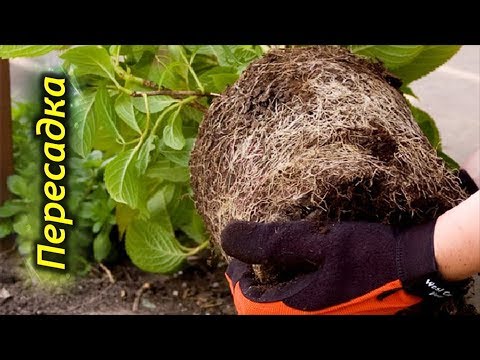

Watch this video on YouTube
Reproduction methods
Cuttings
Propagation of indoor hydrangea by cuttings is the simplest and most efficient way of all. That is why this breeding method is most popular among florists. The optimal time for grafting is January or February. If you root the cutting during this period, then the next fall it will form a multi-stem bush, consisting of three or four stems. If the stalk is planted for rooting in March or April, then a single-stem bush will form.
For harvesting cuttings, it is recommended to use root shoots. The length of the segment should be 70–80 mm, and there can be up to 3 internodes on it. Remove all leaf plates from the bottom of the line. And the leaves in the upper part are shortened by ½ part, if they are large, and by 1/3, if small.
The lower part of the segment is treated with a root growth stimulating agent. Then it is planted for rooting in a mixture of sand and peat. In order for rooting to be successful, the cutting is placed in a well-lit place, the air humidity should be from 75 to 80%, and the temperature should be from 18 to 20 degrees. To maintain the required microclimate, cover the section from above with a transparent cap (for example, a glass jar). Remember to open your cover for a while every day. Make sure that the soil mixture is always slightly damp. The cut should give roots after 20-30 days. After that, it is planted in a permanent pot, reaching from 70 to 90 mm in diameter.
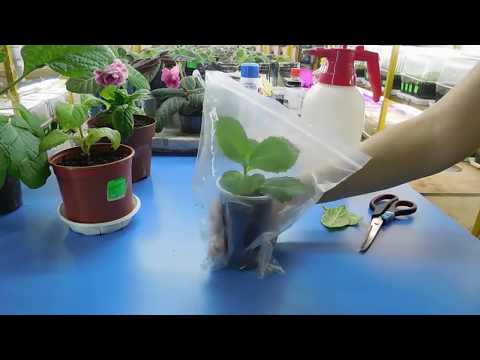

Watch this video on YouTube
Growing from seeds
Hydrangea, if desired, can be grown from seeds, and they should be sown in the last days of February. Take a bowl and fill it with a soil mixture of the following composition: peat, sand, humus, turf and leafy soil (1: 1: 2: 2: 2). Level the surface of the soil mixture, moisten it and evenly distribute the hydrangea seeds, which are small in size, over it. It is not necessary to sprinkle the seeds on top with a substrate. Cover the crops on top with foil or glass. Remember that crops need daily ventilation, and also timely moistening from a spray bottle (the substrate should not dry out).
After the appearance of seedlings, the shelter must be removed completely. A dive into a deeper box is carried out only after a pair of true leaf plates have formed in the bushes. In this case, the substrate is used the same as for sowing. The grown seedlings are transplanted into pots up to 70 mm in diameter.
Reproduction by dividing the bush
The hydrangea is most quickly and easily propagated by dividing the bush. However, in this case, you need to act very carefully, and you also need a certain skill. During the spring transplant, divide the bush into several parts. It should be borne in mind that each section should have a growth point and well-developed roots. Carry out the shortening of the stems and roots of the cuttings, after which they are planted in individual containers, while the surface of the substrate is covered with a layer of peat. If you divide the bush in the spring, then in the fall all its parts will root well.
Possible problems
Pests and diseases
If the humidity is excessively high, it can lead to gray mold damage to the home hydrangea. To save the plant, spray it with a bordeaux mixture solution. Also, high humidity can cause the development of downy mildew. In this case, the bush is treated with a solution of a fungicidal or copper-containing agent.
If the air in the room is too dry, aphids or spider mites can settle on the plant. To get rid of them, the bush is sprayed 2 times with a solution of Actellik or soap with a break of 7 days.
Hydrangea turns yellow
Hydrangea foliage may start to turn yellow for the following reasons:
- poor or sparse watering;
- the plant needs nitrogen;
- the bush is affected by chlorosis (this is due to the too alkaline substrate in the container).
To save the shrub, simply correct the existing care errors.
Hydrangea dries
Sometimes flower growers are faced with the fact that the plant begins to dry out. This can happen due to:
- violations of the irrigation regime;
- not enough frequent humidification from a spray bottle;
- untimely feeding;
- trauma to the root system during transplantation.
Hydrangea falls
Most often, the leaves begin to fly around after they dry out. Remember that this is a moisture-loving plant, and therefore it is necessary to water and moisten it regularly with a spray bottle.
Hydrangea does not bloom
Most often this is due to warm wintering. A bush exhausted after an abundant long flowering cannot recover its strength in a warm and bright place. He needs coolness and darkness during the rest period. In such a place, the hydrangea should stay from 70 to 80 days. A basement or a dark room is suitable for wintering a bush. Cut off all the foliage from him, shorten the powerful stems by ½ part, and cut the weak ones at the root. The prepared bush together with the pot is transferred to a cool place and laid on its side. The culture is sent for wintering in December, and in February it already begins to revive. If everything is done correctly, then the bush will bloom magnificently and for a long time every year.


Watch this video on YouTube
Types of home hydrangea with photo
Under indoor conditions, only large-leaved hydrangea (Hydrangea macrophylla), which is also called garden hydrangea, is grown. And also for this, many of its varieties are used (more than a hundred).
Varieties with cream and white inflorescences:
- M-me E. Mouillere... The inflorescences reach 18 to 20 centimeters across, and the flowers are 20–60 mm. This plant differs from other varieties in narrower foliage.
- Souer tharese... An early flowering low-growing bush reaches a height of 35 to 40 centimeters. The inflorescences consist of regular-shaped flowers, and in diameter they reach from 15 to 17 centimeters.
Varieties with pink inflorescences:
- Goliath... The late-flowering plant reaches a height of 0.6 to 0.7 m. The deep pink large inflorescences reach about 30 centimeters in diameter. The edge of the sepals is deeply cut.
- Hamburg... The plant has a height of 0.35-0.4 m. In diameter, the inflorescences reach 16-18 centimeters, while they consist of pink flowers with a diameter of 40-50 mm.
- Europe... The height of the lush flowering bush is 0.4–0.5 m. The diameter of the inflorescences is 20–25 centimeters, and the diameter of the flowers is about 60 millimeters.
Varieties with red inflorescences:
- Red sensation... Inflorescences are reddish-claret. If you add iron salts to the substrate, then they will turn into a burgundy-purple hue.
- Prima... This plant belongs to the mid-flowering varieties, while its height is from 20 to 25 centimeters. Small flowers in diameter, reaching 35 mm, are collected in small inflorescences (15-18 centimeters in diameter).
Varieties with blue inflorescences:
- Earley Blue... This vigorous plant is adorned with deep blue inflorescences.
- Ramars mars... In a compact bush, the inflorescences reach up to 20 centimeters across. Gradually, the edges of the petals are painted in a greenish tint.
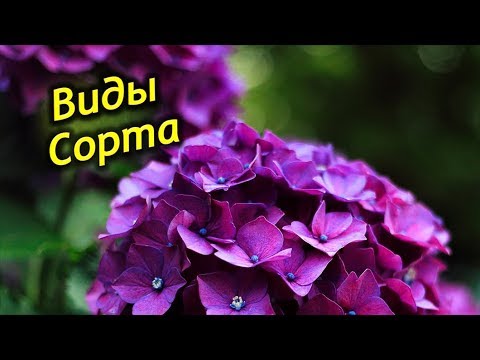

Watch this video on YouTube

